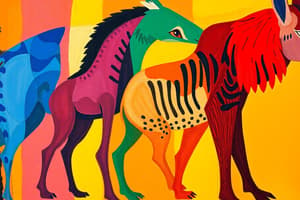Podcast
Questions and Answers
What is a characteristic feature of all animals?
What is a characteristic feature of all animals?
- Multicellularity (correct)
- Autotrophy
- Cell walls
- Photosynthesis
Which of the following is true about animal nutrition?
Which of the following is true about animal nutrition?
- Herbivores consume autotrophs (correct)
- Animals can produce their own food from inorganic chemicals
- Animals rely on photosynthesis for energy
- Animals have cell walls to aid in digestion
What holds cells of animal bodies together?
What holds cells of animal bodies together?
- Cell walls
- Chlorophyll
- Starch
- Extracellular frames of structural proteins (correct)
What is the main reason for the active movement of animals?
What is the main reason for the active movement of animals?
Which group of animals consume both autotrophs and heterotrophs?
Which group of animals consume both autotrophs and heterotrophs?
Animals lack rigid cell walls, unlike which group of organisms?
Animals lack rigid cell walls, unlike which group of organisms?
What is a characteristic that is shared by all animals?
What is a characteristic that is shared by all animals?
Which feature characterizes only some types of animals?
Which feature characterizes only some types of animals?
What type of symmetry is exhibited by jellyfish, sea anemones, and corals?
What type of symmetry is exhibited by jellyfish, sea anemones, and corals?
What is the fundamental difference between radial and bilateral symmetry?
What is the fundamental difference between radial and bilateral symmetry?
What type of reproduction do most animals engage in?
What type of reproduction do most animals engage in?
What do animal eggs lack in comparison to sperm?
What do animal eggs lack in comparison to sperm?
What is the term for the series of mitotic divisions that produce a ball of cells after fertilization?
What is the term for the series of mitotic divisions that produce a ball of cells after fertilization?
What is the term for the structural and functional units into which cells of most animals are organized?
What is the term for the structural and functional units into which cells of most animals are organized?
Flashcards are hidden until you start studying
Study Notes
Characteristics of Animals
- A characteristic feature of all animals is the ability to move, which is not seen in plants or fungi.
Animal Nutrition
- Animals are heterotrophs, meaning they obtain energy by consuming other organisms or organic matter.
Cell Structure
- Cells of animal bodies are held together by collagen, a type of protein.
- Unlike plants, animals lack rigid cell walls.
Movement and Locomotion
- The main reason for the active movement of animals is to find food, escape predators, and reproduce.
Omnivores
- Omnivores are a group of animals that consume both autotrophs (plants) and heterotrophs (other animals).
Symmetry
- Jellyfish, sea anemones, and corals exhibit radial symmetry, where body parts are arranged around a central axis.
- Radial symmetry is different from bilateral symmetry, where body parts are arranged on both sides of a central axis, like in humans.
Reproduction
- Most animals engage in sexual reproduction, where an egg and sperm fuse to form a zygote.
- Animal eggs lack flagella, which are found in sperm, allowing them to move.
Development
- The term for the series of mitotic divisions that produce a ball of cells after fertilization is cleavage.
- The term for the structural and functional units into which cells of most animals are organized is tissue.
Studying That Suits You
Use AI to generate personalized quizzes and flashcards to suit your learning preferences.




